
The Presbyterian Church (USA), abbreviated PCUSA, is a mainline Protestant denomination in the United States. It is the largest Presbyterian denomination in the country, known for its progressive stance on doctrine and its ordaining of women and members of the LGBT community as elders and ministers. The Presbyterian Church (USA) was established with the 1983 merger of the Presbyterian Church in the United States, whose churches were located in the Southern and border states, with the United Presbyterian Church in the United States of America, whose congregations could be found in every state.

John Witherspoon was a Scottish-American Presbyterian minister, educator, farmer, slaveholder, and a Founding Father of the United States. Witherspoon embraced the concepts of Scottish common sense realism, and while president of the College of New Jersey became an influential figure in the development of the United States' national character. Politically active, Witherspoon was a delegate from New Jersey to the Second Continental Congress and a signatory to the July 4, 1776, Declaration of Independence. He was the only active clergyman and the only college president to sign the Declaration. Later, he signed the Articles of Confederation and supported ratification of the Constitution of the United States.

Princeton Theological Seminary (PTSem), officially The Theological Seminary of the Presbyterian Church, is a private school of theology in Princeton, New Jersey. Founded in 1812 under the auspices of Archibald Alexander, the General Assembly of the Presbyterian Church (USA), and the College of New Jersey, it is the second-oldest seminary in the United States. It is also the largest of ten seminaries associated with the Presbyterian Church.
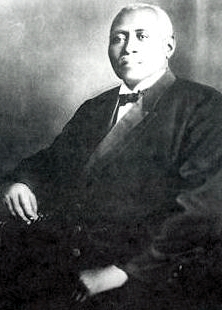
William Drew Robeson I was the minister of Witherspoon Street Presbyterian Church in Princeton, New Jersey from 1880 to 1901 and the father of Paul Robeson. The Witherspoon Street Presbyterian Church had been built for its black members by the First Presbyterian Church of Princeton.
Warrenton Presbyterian Church is a Presbyterian Church (USA) congregation located at 133 Watts Road near Abbeville in Abbeville County, South Carolina.

The Cold Spring Presbyterian Church is a Presbyterian church in Cold Spring, New Jersey, founded in 1714.
Princeton University was founded in Elizabeth, New Jersey, in 1746 as the College of New Jersey, shortly before moving into the newly built Nassau Hall in Princeton. In 1783, for about four months Nassau Hall hosted the United States Congress, and many of the students went on to become leaders of the young republic.

Fifth Avenue Presbyterian Church is a Presbyterian Church (U.S.A.) church in New York City. The church, on Fifth Avenue at 7 West 55th Street in Midtown Manhattan, has approximately 2,200 members and is one of the larger PCUSA congregations. The church, founded in 1808 as the Cedar Street Presbyterian Church, has been at this site since 1875.

First Presbyterian Church is an historic Presbyterian church located at 642 Telfair Street in Augusta, Georgia in the United States.
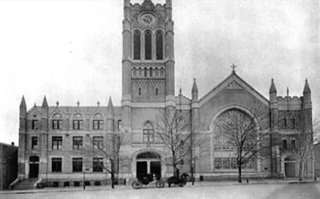
The congregation of North Presbyterian Church, at 525 West 155th Street in Manhattan, New York City, is a combination of three former congregations: North Presbyterian Church, Washington Heights Presbyterian Church, and St. Nicholas Avenue Presbyterian Church.

First Presbyterian Church is a historic Presbyterian church located at Poughkeepsie, Dutchess County, New York. It was built in 1905 and is a large, five-sided stone building with a wing. It features a three-story square tower with a pyramidal roof and arched Romanesque window surrounds.

The First Presbyterian Church, known as "Old First", is a church located at 48 Fifth Avenue between West 11th and 12th Streets in the Greenwich Village neighborhood of Manhattan, New York City. It was built in 1844–1846, and designed by Joseph C. Wells in the Gothic Revival style. The south transept of the building was added in 1893–1894, and was designed by the firm of McKim, Mead & White. The church complex, which includes a parish house – now referred to as the "South Wing" – on West 11th Street and a church house on West 12th Street designed by Edgar Tafel, is located within the Greenwich Village Historic District.
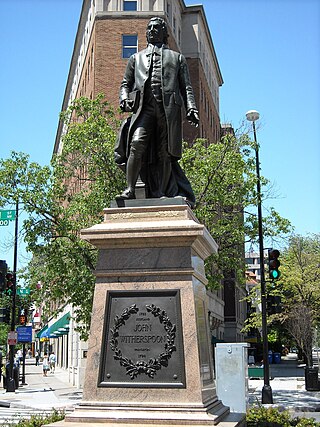
Doctor John Witherspoon is a bronze sculpture and granite pedestal which depicts John Witherspoon, a Presbyterian minister, member of Congress, and signer of the Declaration of Independence. Born in Scotland, Witherspoon immigrated to the U.S. in the 1760s and later became president of the College of New Jersey. He strongly supported the Thirteen Colonies in their fight to obtain freedom from the United Kingdom of Great Britain and Ireland.
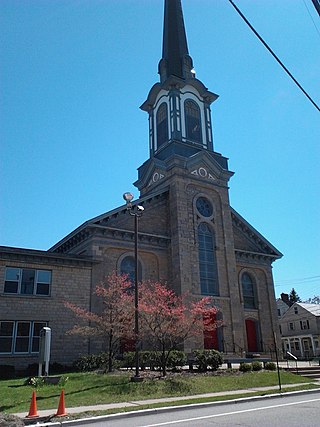
The First Presbyterian Church of Newton is a Christian house of worship affiliated with the Presbyterian Church (USA) located in the Town of Newton in Sussex County, New Jersey. This congregation, established in the 1780s, is overseen by the Highlands Presbytery.
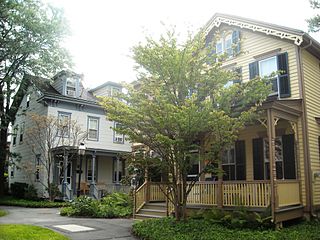
The Princeton Historic District is a 370-acre (150 ha) historic district located in Princeton, New Jersey that was listed on the U.S. National Register of Historic Places in 1975. It stretches from Marquand Park in the west to the Eating Clubs in the East, from the Princeton Cemetery in the north to the Graduate College in the south. The district encompasses the core parts of the campuses of the Princeton Theological Seminary and Princeton University. It also includes the business district centered on Nassau Street and many historic homes, both mansions in the western section and more humble dwellings in the Witherspoon/Jackson neighborhood. Notable churches within the district include Nassau Presbyterian Church, Trinity Episcopal, Nassau Christian Center, and the Princeton University Chapel. The district is home to seven of Princeton's nine, and New Jersey's fifty-eight, National Historic Landmarks, the largest concentration of such sites in the state.

The Church of the Pilgrims is a Presbyterian Church (USA) congregation located in Washington, D.C., in the United States. The congregation was founded in 1903 as the Second Southern Presbyterian Church and took its current name in 1919. The congregation resides in a Gothic Revival church located at 22nd Street NW and P Street NW. The building was designed by architect Benjamin C. Flournoy of Baltimore, Maryland, and completed in March 1929.

Stone Hill Church of Princeton is a gospel-centered, nondenominational church in Princeton, New Jersey, United States. The church was founded in 1956 as Westerly Road Church at the intersection of Westerly and Wilson Roads. In 2013, it constructed a new facility and relocated to 1025 Bunn Drive and changed its name to Stone Hill Church of Princeton. The Rev. Dr. Matthew P. Ristuccia, a member of the Princeton University class of 1975, served as senior pastor from 1985 until his retirement in 2020.
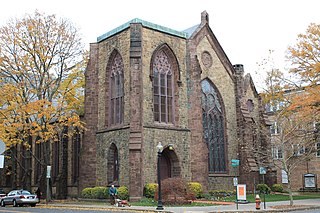
The Nassau Christian Center is an Assemblies of God church in Princeton, New Jersey located at 26 Nassau Street. It is housed in an historic church building built in 1868 that was once home to Princeton's Second Presbyterian Church, later known as St. Andrew's Presbyterian. The Christian Center was founded in 1978 and leased, purchasing in 1980, the then empty building from Nassau Presbyterian Church, which had been formed by the merger of Second Presbyterian with First Presbyterian of Princeton in 1973.

Princeton United Methodist Church is a United Methodist congregation located at 7 Vandeventer Avenue in Princeton, New Jersey. The church is located on Nassau Street, directly across from Princeton University.
Witherspoon Street Presbyterian Church was founded in 1839 in Princeton, New Jersey. The church was formed after the Nassau Presbyterian Church allowed 90 of the 131 former African American members to form their own church, after a fire had devastated the Nassau church. The church is among New Jersey's oldest African American Presbyterian congregations.
























